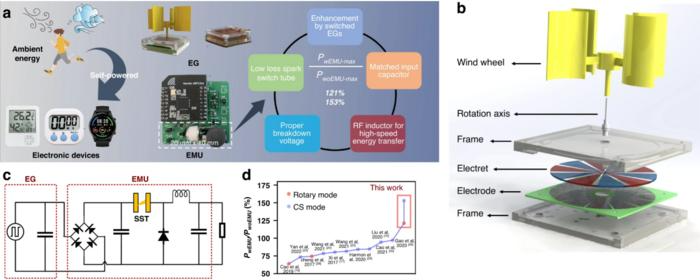Scientists have engineered an advanced energy management unit (EMU) that notably enhances the efficacy of electrostatic generators intended for Internet of Things (IoT) applications. This advancement tackles the issue of high impedance disparity between electrostatic generators and electronic devices, opening up fresh avenues for ambient energy collection.

Design and performance of the EMU for EGs to power an IoT node. a. Illustration of EGs with a remarkably good performance in harvesting ambient energy to power electronic devices. b Structural diagram of REG for wind energy harvesting. c Circuit schematic of the EMU for REG. d Ratio of the maximum power with an EMU to that without an EMU in this work compared with that reported previously. Image Credit: Microsystems & Nanoengineering.
Utilizing energy from natural sources like wind and human motion, electrostatic generators have become a viable option for Internet of Things (IoT) networks looking to power low-power devices. These generators have the potential to be very effective, but when they are coupled to electronic devices, there is an impedance mismatch that causes low energy usage efficiency.
The research published in the journal Microsystems & Nanoengineering describes an effective energy management unit (EMU) that is intended to greatly increase the power efficiency of electrostatic generators for Internet of Things devices. This breakthrough solves the long-standing impedance mismatch issue and advances the possibility of utilizing ambient energy harvesting in the Internet of Things.
The research team's use of an inventive EMU fitted with a buck converter and spark-switch tube has greatly increased the power efficiency of electrostatic generators. This innovation caused rotary electret generators to produce an unparalleled 79.2 mW m-2 rps-1 of direct current, resulting in a notable increase in efficiency.
Moreover, the EMU improved contact-separated triboelectric nanogenerators' performance by 50 %, showcasing its adaptability to various energy harvesting technologies. This development results from the painstaking optimization of vital parts, like the buck converter and spark-switch tube, which elevated direct current power generation to unprecedented levels.
This advancement not only exceeds current benchmarks for energy efficiency but also highlights the EMU's versatility with a broad range of generator configurations.
Our work represents a significant step towards the practical application of electrostatic generators in IoT devices. By optimizing our EMU, we have achieved unprecedented efficiency, making self-powered IoT devices more viable than ever.
Zeyuan Cao, Study Co-Author, Department of Precision Instrument, Tsinghua University
This innovation not only improves the efficiency and dependability of self-sustaining IoT devices but also streamlines their wider integration into sustainable and remote settings. It signals a new era of energy independence within the IoT, representing a noteworthy progression in environmental energy gathering for IoT purposes.
Journal Reference:
Wu, Z., et al. (2024) Electrostatic generator enhancements for powering IoT nodes via efficient energy management. Microsystems & Nanoengineering. doi.org/10.1038/s41378-024-00660-1.